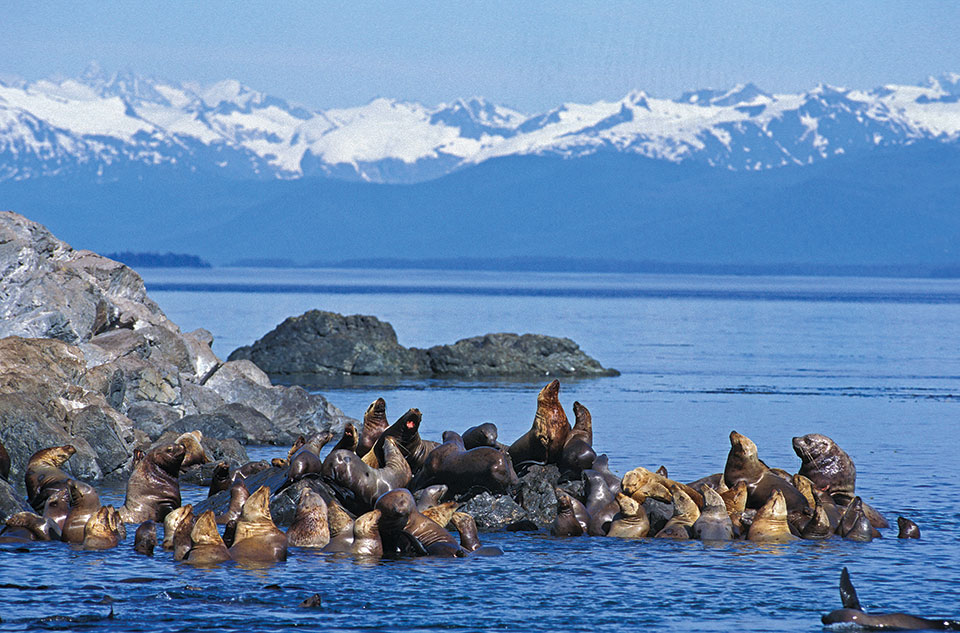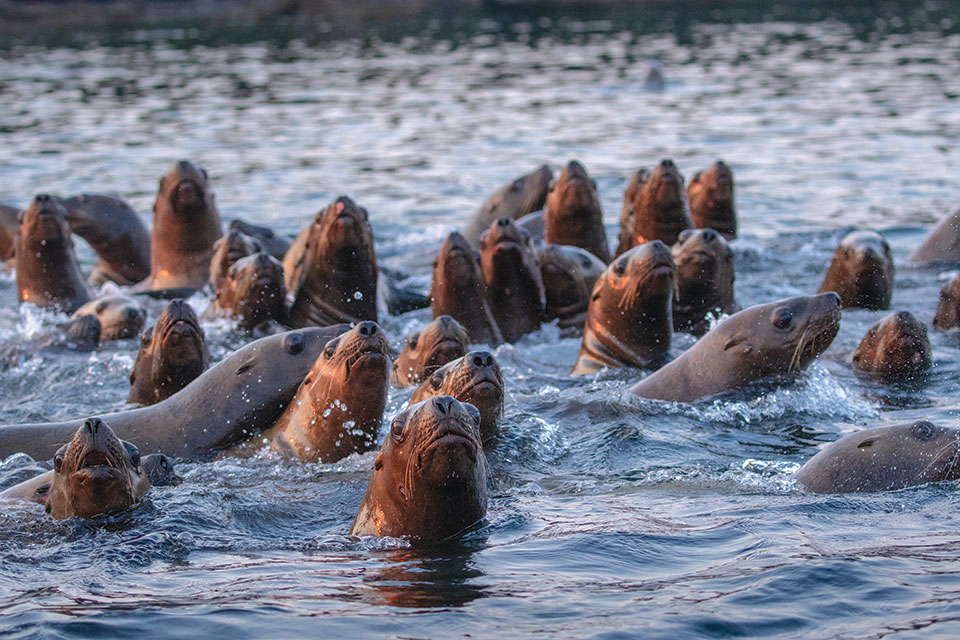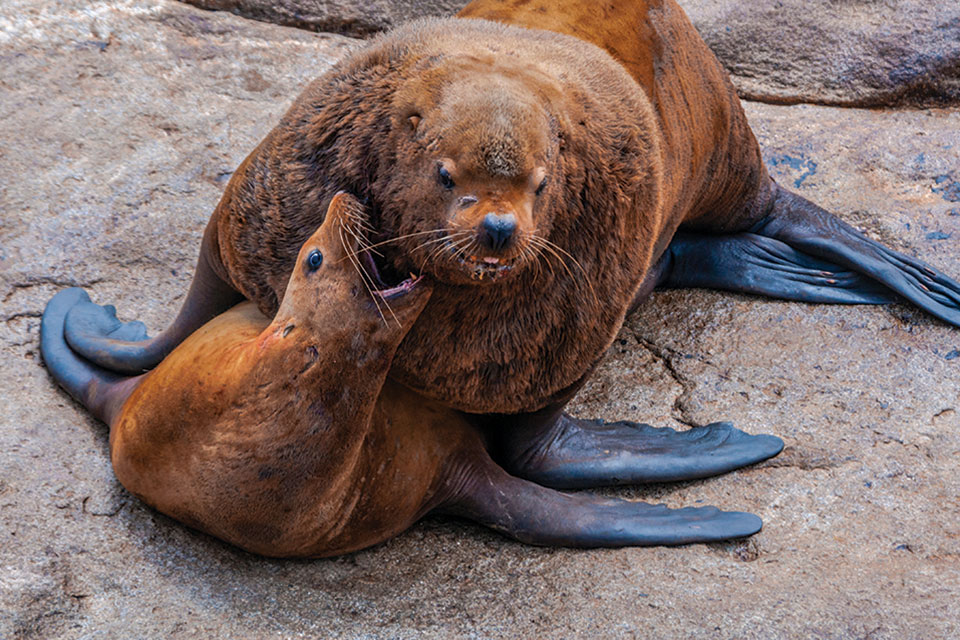
Steller sea lions are found in coastal waters in the northern Pacific Ocean, from Japan to central California. Steller sea lions in U.S. waters are divided into two distinct population groups: the western and eastern populations. The differentiation is based primarily on genetic and physical differences, but also on differing population trends in the two regions.
The most significant drop in numbers was seen in the eastern Aleutian Islands and the western Gulf of Alaska. The extent of this decline led to the steller sea lion species being listed as threatened. In the 1990s, the population decline continued in the western portions of the species’ range, which led officials to divide the species into the two distinct population segments seen today. The western population was listed as endangered in 1997, and there are currently about 46,000 individuals in this group.
The current minimum population estimate for the eastern population is approximately 52,000 individuals. Approximately ten years ago officials removed the eastern group of steller sea lions from the endangered species list because this group no longer met the definition of an endangered or threatened species. Unlike the eastern population, the western group has not met the recovery and de-listing criteria and remains listed as endangered. Steller sea lions are protected under both the Endangered Species Act and the Marine Mammal Protection Act.
They are vulnerable to the effects of climate change on ocean currents, which impacts their fish prey abundance. They are also victims of by-catch in fisheries. Other threats to these animals are boat/ship strikes, pollutants, habitat degradation, and illegal hunting/shooting. Known predators are killer whales and white sharks.
Steller sea lions are similar in appearance to California sea lions and are sometimes confused with them. However, steller sea lions are much larger and lighter in color. Males may grow to 11 feet in length and weigh almost 2,500 pounds. Females are much smaller and may grow to 9 feet in length and weigh 1,000 pounds.
Steller sea lions are light tan to reddish-brown in color. They have a blunt face and a boxy, bear-like head. Adult male steller sea lions have a bulky build and a very thick neck with longer fur that resembles a lion’s mane, hence the name “sea lion.” Sea lions have long front flippers and hind flippers that can rotate, allowing much better movement on land.


Steller sea lions are found in coastal waters in the northern Pacific Ocean, from Japan to central California. Steller sea lions in U.S. waters are divided into two distinct population groups: the western and eastern populations. The differentiation is based primarily on genetic and physical differences, but also on differing population trends in the two regions.
The most significant drop in numbers was seen in the eastern Aleutian Islands and the western Gulf of Alaska. The extent of this decline led to the steller sea lion species being listed as threatened. In the 1990s, the population decline continued in the western portions of the species’ range, which led officials to divide the species into the two distinct population segments seen today. The western population was listed as endangered in 1997, and there are currently about 46,000 individuals in this group.
The current minimum population estimate for the eastern population is approximately 52,000 individuals. Approximately ten years ago officials removed the eastern group of steller sea lions from the endangered species list because this group no longer met the definition of an endangered or threatened species. Unlike the eastern population, the western group has not met the recovery and de-listing criteria and remains listed as endangered. Steller sea lions are protected under both the Endangered Species Act and the Marine Mammal Protection Act.
They are vulnerable to the effects of climate change on ocean currents, which impacts their fish prey abundance. They are also victims of by-catch in fisheries. Other threats to these animals are boat/ship strikes, pollutants, habitat degradation, and illegal hunting/shooting. Known predators are killer whales and white sharks.
Steller sea lions are similar in appearance to California sea lions and are sometimes confused with them. However, steller sea lions are much larger and lighter in color. Males may grow to 11 feet in length and weigh almost 2,500 pounds. Females are much smaller and may grow to 9 feet in length and weigh 1,000 pounds.
Steller sea lions are light tan to reddish-brown in color. They have a blunt face and a boxy, bear-like head. Adult male steller sea lions have a bulky build and a very thick neck with
longer fur that resembles a lion’s mane, hence the name “sea lion.” Sea lions have long front flippers and hind flippers that can rotate, allowing much better movement on land.
Steller sea lions are vocal in air. Mature male sea lions have a range of vocalizations as part of their territorial behaviors, including belches, growls, snorts, and hisses that serve as warnings to others. Both males and females also produce underwater noises similar to their above-water sounds, described as clicks, barks, and belches. The primary function of their vocalizations is for social behavior.
Vocalizations are critical to mother-pup pairs, as the mothers must find their pups in a crowded breeding area when they return from foraging. The mother and pup both use distinctive calls, like names, to help differentiate themselves among the crowd of other sea lions.
The life span of sea lions can be up to 18 years for males and up to 30 years for females. They eat primarily fish and invertebrates.
Breeding occurs in areas ranging from Año Nuevo Island in central California to the Kuril Islands north of Japan, with the greatest concentration of rookeries, or breeding grounds, in the Gulf of Alaska and Aleutian Islands.
During the breeding season, mothers spend roughly equal amounts of time hunting and nursing pups on land and gradually spend more time at sea as their pups get older. Pups usually nurse for a year, but some continue to nurse for up to three years.
During the breeding season, males do not eat.
Pups typically are born from mid-May to mid-July, weighing 35 to 50 pounds. Mothers stay with their pups for one to two weeks before going off to hunt at sea. Female sea lions usually give birth to one pup per year.
